Connecting a double-circuit gas boiler to the heating system: requirements and norms + installation steps
Gas equipment like boiler + water heater is a suitable solution for owners of apartments and private houses: heat is provided, hot water is available, economically. And the connection of a double-circuit gas boiler to the heating system is not as complicated as it seems. But before embarking on the implementation of such a project, it would not be superfluous to get acquainted with the theory, agree?
In this publication, we will talk about the features of the connection process: what requirements of service organizations need to be taken into account and what technical nuances of mounting wall and floor models should be paid special attention to. Supplemented material with visual photos and videos, which will help to complete all the work as quickly as possible and without errors.
The content of the article:
Hardware Installation Rules
Installation and connection of the boiler to the system should begin after passing through the design phase, when a place in the house is prepared for the unit. If you install it in violation of the requirements, the specialists of the gas distribution company will not connect the equipment to the gas pipeline.
General requirements at the design stage
The basic norms for installing gas equipment are spelled out in SNiP 42-01-2002. Supporting information is contained in the already invalid, but useful SNiP 2.04.08-87.
Usually, all the rules are taken into account by the design engineer, but it’s good for them to know. The room for the location of the boiler can be a kitchen, if the power of the device varies in the range up to 60 kW. A separate or attached furnace is relevant for units with a power rating of up to 150 kW.
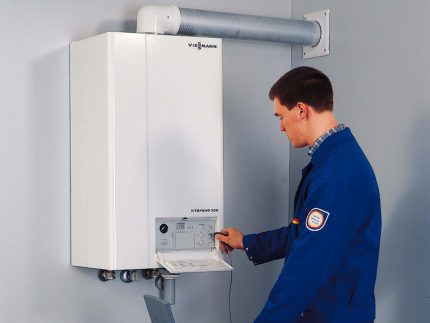
The room requirements are as follows:
- The minimum value of the height of the room is 2 m, volume - 7.5 m3. If there are two or more gas appliances, the parameters change by 2.5 m and 13.5 m3 respectively.
- Not suitable for installation: basements, balconies, bathrooms, corridors, rooms without windows.
- The walls of the room must be covered with non-combustible materials or protected with special panels.
- Lighting: at 10 m3 rooms have a minimum of 0.3 m2 window. In a gas explosion, windows are an easy-to-clean design, which increases equipment safety.
- Mandatory grounding, cold water pipeline.
- The cross section of the chimney corresponds to the power of the installed equipment.
- The space around the device is left: in front - from 1.25 m, on the sides (if maintenance is necessary) - from 0.7 m.
- The distance from the vertical chimney to the unit is observed - no more than 3 m.
Ventilation should also be provided. Natural is calculated in the amount of 3 room volumes per hour. When organizing the supply, combustion air is added to this value (the parameter is indicated in the boiler passport).
Requirements apply not only to premises. The distance from the attachment to the nearest structures is also regulated. This information is indicated by the manufacturer in the equipment manual.
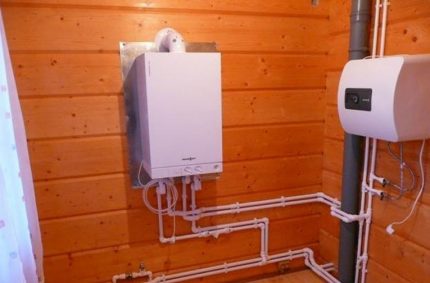
Floor models of boilers are installed on non-combustible substrates. If the surface is wooden, a metal backing is required.
It is recommended to place the device as close to the gas pipe as possible. The use of special hoses is permissible, but they should not be long. On sale there are bellows hoses up to 5 m, they are allowed for installation, but according to European standards, the length is limited to two meters.
Documentation Process
After a general acquaintance with how to technically correctly connect dual-circuit gas boilers, you can begin to prepare documentation. First step - getting TU. It is necessary to contact the regional gas service with a statement indicating the estimated volume of gas consumption per hour.
Specifications are issued in 1-2 weeks. The document is a permit to connect housing to the gas main.
The second stage - according to the specifications equipment installation project. Third - statement prepared documentation by engineers of a gas distribution company.
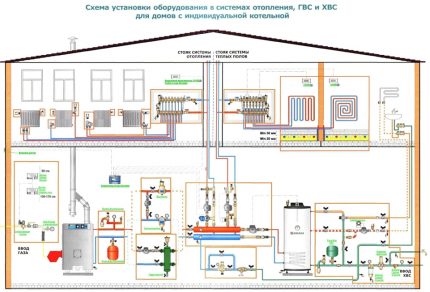
The boiler’s data sheet, operating instructions, certificates, expert opinion on the compliance of the device with all standards are submitted to the controlling organization. The necessary papers are provided by the manufacturer of the double-circuit boiler.
Coordination of documentation can occur in a week or last up to 3 months, it all depends on the complexity of the project. In case of refusal, the inspection is obliged to provide a list of corrections to eliminate the deficiencies. If all the requirements are met, seals are affixed and you can begin to connect the equipment.
Features tying the wall model
First, you need to make connections to the heating system, water supply system and electrical network, if the device has elements of control and regulation. Connection to the gas main is carried out by an employee of the corresponding service or a licensed company. The owner only needs to buy counter and gas filter.

What products and materials will be needed in the process:
- 3 ball valves with American size 1/2 ″ and 4 of the same size 3/4 ″;
- 2 sumps (mechanical or self-washing) - are installed on the supply of cold water and the return pipe of the heating pipe;
- gas filter;
- expansion tank (if its volume is not enough for a large pipeline network, you also need a membrane tank);
- pipe fittings - elbows, tees;
- three-core cable (VVG brand, cross section 2.5 mm2);
- 20 A circuit breaker
This list is suitable for heat generators of simple design with an open combustion chamber. Expensive models are equipped with an expansion tank and a gas filter.
If the water pressure is less than 1 atm, it is worth setting pressure boosting station. It is useless provided that the water pressure is constant within 2-3 atm.
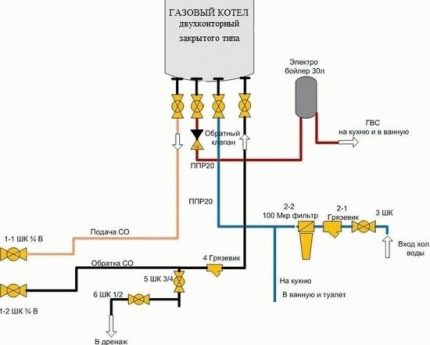
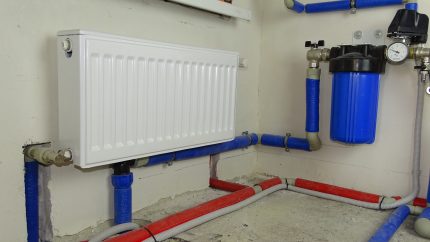
Next, we hang the boiler on the wall, determining the optimal height. Hanging under the ceiling is not important - ease of use is important. The minimum distance from the ceiling to the outlet pipe is 15 cm, from the floor - 80 cm, from the wall - 20 cm.
To install the device you will need two special brackets, which are supplied. They are mounted on the wall with plastic dowels and screws. To set them correctly, it is recommended to use the level and plumb line.
Stage # 1 - connection to the heating system
All Ball Valves for blocking the pipeline, more are installed to service the system than taking into account its possible cutting-off and dismantling during operation. Heating equipment is characterized by reliability. Example: a shut-off valve on the heating return is used to clean the filter without draining the coolant.
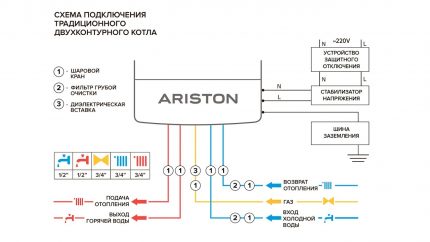
Connection recommendations:
- Half-inch taps are mounted on water fittings and a gas supply. And DN20 are mounted on pipes with a coolant.
- The fittings must be screwed with the nozzles down.
- Filters are attached horizontally, "spouts" are turned to the floor. In this position, it is convenient to clean them.
- An external expansion tank is connected to the return using additional fittings.
- The drain pipe is installed at the lowest point of the system.
If you plan to upload to the system as coolant non-freezing antifreeze; for reinsurance, additional taps for feeding and returning should be added to the scheme. This makes it possible to dismantle the boiler without draining the antifreeze.
Stage # 2 - connecting the boiler to the mains
With the supply of electricity, usually there are no difficulties - just plug the device into a power outlet. But there are also rules and safety requirements.
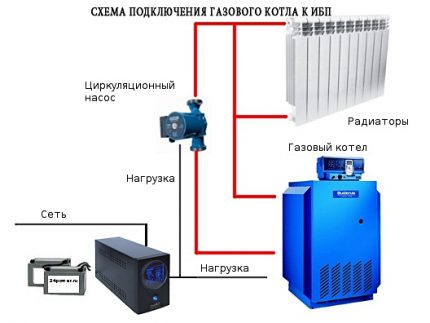
The main requirement when connecting the device to the network is grounding and the presence of a circuit breaker. The latter is located so that in case of emergency it does not get water.
Primary requirements:
- Need a wire connected to the ground loop. If there was no such cord in the kit, the conductor is connected to the body of the device itself.
- As earthing switches, it is forbidden to use steel pipes of the DHW system.
- The cable is laid in a protective "corrugation".
When connecting turbocharged boilers from European manufacturers it is important not to confuse phase with zero. Otherwise, the electronic unit will not start the system.
Stage # 3 - connecting the unit to the chimney
In 95% of modern homes, wall-mounted boilers with closed-type combustion chambers and coaxial chimney. It is discharged horizontally through the wall with a slope of 3-5% towards the street to allow condensate to escape.

Only a vertical design that can handle large volumes of combustion products is suitable for a large outdoor unit. It should have as few turns as possible and protrude beyond the boundaries of the roof at a distance of 0.5 m.
Mounting the outdoor appliance
If a double-circuit heat generator requires power, then it is connected similarly to a wall-mounted “colleague”. The non-volatile device has a built-in coil made of copper or stainless steel for heating water. In addition to the burner, automation and heat exchanger, nothing is supplied with such equipment.
To install a non-volatile unit, you will need a set from the previous list plus the following system elements:
- security group, the safety valve of which is designed for the operating pressure of the boiler (data is in the passport);
- expansion tank with a volume of 10% of the total amount of coolant;
- circulation pump.
A safety group is always installed on the supply pipe next to the heater in order to protect the most expensive part of the system from destruction during a sharp pressure surge.

If the floor appliance is connected to a gravity flow system, only an open expansion tank with overflow is mounted. The pump and safety group are excluded from the scheme.
In this situation, pipes with a diameter of 40 mm or more are needed, which are laid at a slope of 5 mm for each linear meter of the line. The heat generator remains at the lowest point, the tank is located at the highest.
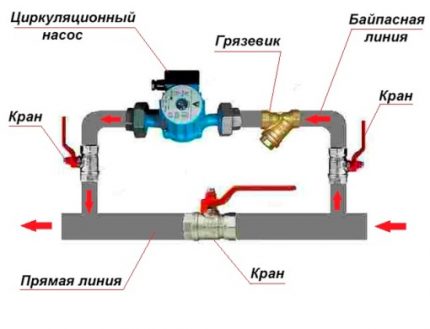
Most modern systems include circulation pumpthat is effective, but dependent on electricity. When the light is turned off, heating and water heating are turned off. It is wise to organize an alternative natural circulation method for force majeure.
Variants of schemes with a boiler
When the standard power of the device of 9-13 liters is not enough to meet the needs of residents (example: there is a bath in the bathroom), the system is supplemented by a boiler. If selected indirect heating boiler, then it is impossible to simulate the duct with an additional circulation pump, which is switched on and stopped by the thermostat signal.
An incorrect circuit entails a problem in the form of prolonged heating of the boiler. At this time (up to 2 hours) the heating of the house does not occur, the premises cool down. Plus, the boiler resource is reduced due to the “ticking” effect and the entry of hot water into the second circuit, rather than cold. In the boiler itself, bacteria multiply.

In such a scheme, heating between the circuits is provided by a three-way valve. The boiler is loaded in 20-25 minutes. Plugs do not affect the life of the heat generator.
More practical options are installing a layer-by-layer boiler (there are models for double-circuit) or an electric drive.The former does not have a heat exchanger, which reduces the cost of the system. The second significantly improves the comfort of using hot water.
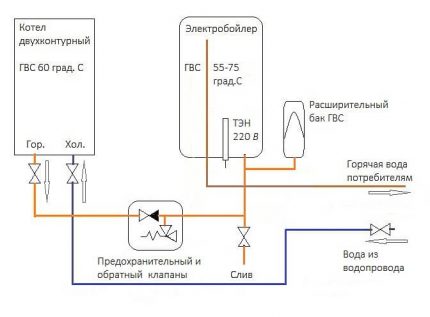
In the case of an electric boiler, it is recommended to additionally install an expansion tank. And if the pressure in the system is more than 6-8 bar, you will need a pressure reducing valve to reduce it.
Additional installation recommendations
Categorically it is impossible to reduce the diameter of the internal section of the connected pipes. The optimal value for a boiler up to 28 kW is at least 20 mm for heating and at least 15 mm for water supply.
If the boiler is not included in the circuit, it is more reasonable to install the device closer to the hot water tap, which is often used.
In case of connection warm floors, the system is supplemented by a separate branch with a collector and a circulation pump.
Conclusions and useful video on the topic
The principle of operation of a double-circuit boiler. Advantages and limitations of the model.
Analysis of the connection circuit of a dual-circuit heat generator with recommendations on the nuances of the installation.
Connecting a boiler to the system is a consequence of improper installation.
After collecting and preparing the documentation, it is necessary to connect a double-circuit boiler to heating, electricity and a chimney. The devices are different, but the requirements for their installation are the same. Features of a particular model are indicated in the instruction manual.
It is wiser to entrust the first start-up of the unit to a gas service specialist. He will test the dual-circuit, check all the blocks, set the modes and instruct the owner on the operation of the equipment.
Do you want to share your own experience in installing and connecting a domestic dual-circuit boiler? Tell us about the difficulties that you encountered in the process - leave your comments in the block under the article.
If you have questions about the rules of connection or installation, ask them to our experts and other visitors to the site - the feedback form is located below.

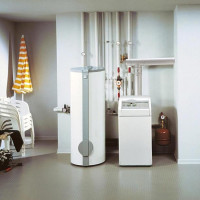 The principle of operation of a dual-circuit gas heating boiler and features of its connection
The principle of operation of a dual-circuit gas heating boiler and features of its connection 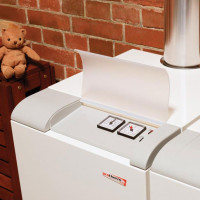 Installation of a gas boiler Protherm: features and main stages of installation + wiring diagrams
Installation of a gas boiler Protherm: features and main stages of installation + wiring diagrams 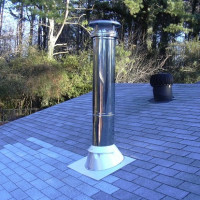 Chimney for a gas boiler: types of structures, installation tips, standards and installation requirements
Chimney for a gas boiler: types of structures, installation tips, standards and installation requirements 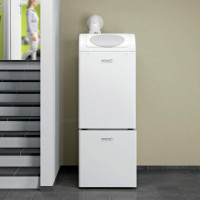 Rules for connecting a dual-circuit gas boiler to gas
Rules for connecting a dual-circuit gas boiler to gas 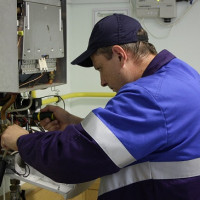 Replacing a gas boiler in a private house: norms and rules for completing the procedure for replacing gas equipment
Replacing a gas boiler in a private house: norms and rules for completing the procedure for replacing gas equipment 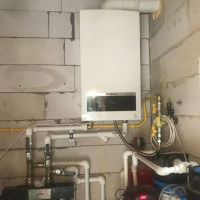 Grounding a gas boiler in a private house: standards, features of the device and checks
Grounding a gas boiler in a private house: standards, features of the device and checks  How much does it cost to connect gas to a private house: the price of organizing gas supply
How much does it cost to connect gas to a private house: the price of organizing gas supply  The best washing machines with dryer: model rating and customer tips
The best washing machines with dryer: model rating and customer tips  What is the color temperature of light and the nuances of choosing the temperature of the lamps to suit your needs
What is the color temperature of light and the nuances of choosing the temperature of the lamps to suit your needs  Replacement of a geyser in an apartment: replacement paperwork + basic norms and requirements
Replacement of a geyser in an apartment: replacement paperwork + basic norms and requirements
“... First, you need to make connections to the heating system, water supply system and electric network, if the device has elements of control and regulation.”
In the case of connecting a hinged boiler-boiler, this requirement is dictated by what? Is there any SNiP where it is written that before connecting to the gas, the column must be connected to the water heating circuit and to the mains?
Good afternoon! The rules and sequence for connecting gas appliances are regulated by SNiP42-01-2002, introduced instead of the inactive SNiP 2.04.08-87. The document states that the connection to the gas should be carried out only the final installation of equipment.
In your case, the sequence will be like this:
1) installation of a boiler column;
2) connection to the water supply system;
3) connection to the power supply system;
4) connection to the gas supply system.
Hello.Are you talking about a dual-circuit boiler? How do you imagine its operation without power supply (a fan, a piezo (if any), a pump, and even more so, without water? You won’t do an elementary test run). Where it is written ... yes, at least in the instrument passports.
I looked through a hundred photos of the harness and I don’t understand one joke. In half the photo (including yours), the input filter is in the wrong position. One photo struck me at all - on each nozzle of the boiler there is a filter and they are all in one direction.